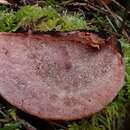en
names in breadcrumbs


Fomitopsis cajanderi is a widely distributed bracket fungus. Commonly known as the rosy conk due to its rose-colored pore surface, it causes a disease called a brown pocket rot in various conifer species.[1] It is inedible.[2] It is widespread in Western North America, with more prevalence in southern climates.[1] It has a particular preference for higher-altitude spruce forests.[1]
F. cajanderi is a perennial shelf fungus.[1] It may be identified by its small-to-medium-sized, fleshy, tough fruit-body, with a downy or crust-like top.[3] It grows to around 3–10 cm (1.2–3.9 in) wide.[4] The top surface is a pink colour becoming to grey, brown, or black, with a clear margin.[1] The inside of the conk and the bottom are a rosy pink colour.[1] The body of the fungus is rigid and can grow up to 1 cm thick.[1] There are 3–5 round pores per millimeter.[1]
This polypore is morphologically similar to its relative, Fomitopsis rosea. Other similar species include Fomitopsis pinicola, Ganoderma lucidum, G. oregonense, and Oligoporus placentus.[4]
Fomitopsis cajanderi is a widely distributed bracket fungus. Commonly known as the rosy conk due to its rose-colored pore surface, it causes a disease called a brown pocket rot in various conifer species. It is inedible. It is widespread in Western North America, with more prevalence in southern climates. It has a particular preference for higher-altitude spruce forests.